超细粉体表面包覆与改性
超细钛酸钡的表面改性_崔爱莉
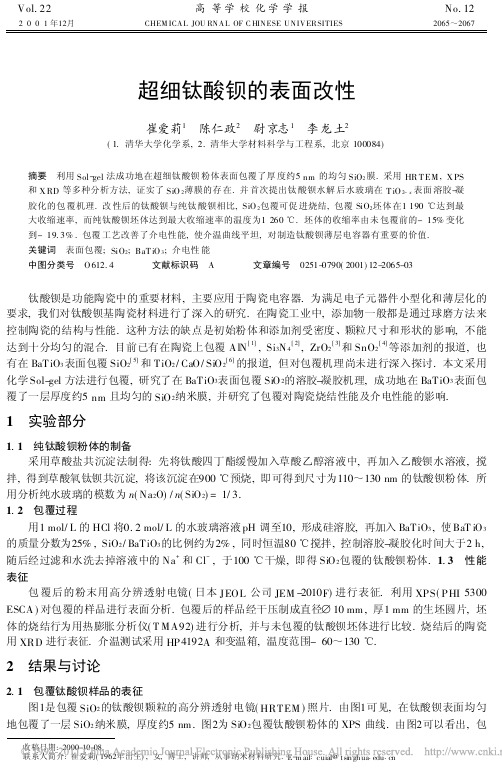
Vol.22高等学校化学学报 No.12 2001年12月 CHEM ICAL JOU RNAL OF C HINESE UNIVERSITIES 2065~2067 超细钛酸钡的表面改性崔爱莉1 陈仁政2 尉京志1 李龙土2(1.清华大学化学系, 2.清华大学材料科学与工程系,北京100084)摘要 利用Sol-gel法成功地在超细钛酸钡粉体表面包覆了厚度约5nm的均匀SiO2膜.采用HR T EM,X PS 和X RD等多种分析方法,证实了SiO2薄膜的存在.并首次提出钛酸钡水解后水玻璃在T iO2-x表面溶胶-凝胶化的包覆机理.改性后的钛酸钡与纯钛酸钡相比,SiO2包覆可促进烧结,包覆SiO2坯体在1190℃达到最大收缩速率,而纯钛酸钡坯体达到最大收缩速率的温度为1260℃.坯体的收缩率由未包覆前的-15%变化到-19.3%.包覆工艺改善了介电性能,使介温曲线平坦,对制造钛酸钡薄层电容器有重要的价值.关键词 表面包覆;SiO2;BaT iO3;介电性能中图分类号 O612.4 文献标识码 A 文章编号 0251-0790(2001)12-2065-03钛酸钡是功能陶瓷中的重要材料,主要应用于陶瓷电容器.为满足电子元器件小型化和薄层化的要求,我们对钛酸钡基陶瓷材料进行了深入的研究.在陶瓷工业中,添加物一般都是通过球磨方法来控制陶瓷的结构与性能.这种方法的缺点是初始粉体和添加剂受密度、颗粒尺寸和形状的影响,不能达到十分均匀的混合.目前已有在陶瓷上包覆AlN[1],Si3N4[2],ZrO2[3]和SnO2[4]等添加剂的报道,也有在BaTiO3表面包覆SiO2[5]和TiO2/CaO/SiO2[6]的报道,但对包覆机理尚未进行深入探讨.本文采用化学Sol-gel方法进行包覆,研究了在BaTiO3表面包覆SiO2的溶胶-凝胶机理,成功地在BaTiO3表面包覆了一层厚度约5nm且均匀的SiO2纳米膜,并研究了包覆对陶瓷烧结性能及介电性能的影响.1 实验部分1.1 纯钛酸钡粉体的制备采用草酸盐共沉淀法制得:先将钛酸四丁酯缓慢加入草酸乙醇溶液中,再加入乙酸钡水溶液,搅拌,得到草酸氧钛钡共沉淀,将该沉淀在900℃预烧,即可得到尺寸为110~130nm的钛酸钡粉体.所用分析纯水玻璃的模数为n(Na2O)/n(SiO2)=1/3.1.2 包覆过程用1mol/L的HCl将0.2mol/L的水玻璃溶液pH调至10,形成硅溶胶,再加入BaTiO3,使BaT iO3的质量分数为25%,SiO2/BaTiO3的比例约为2%,同时恒温80℃搅拌,控制溶胶-凝胶化时间大于2h,随后经过滤和水洗去掉溶液中的Na+和Cl-,于100℃干燥,即得SiO2包覆的钛酸钡粉体.1.3 性能表征包覆后的粉末用高分辨透射电镜(日本JEOL公司JEM-2010F)进行表征.利用XPS(PHI5300 ESCA)对包覆的样品进行表面分析.包覆后的样品经干压制成直径 10mm,厚1mm的生坯圆片,坯体的烧结行为用热膨胀分析仪(T MA92)进行分析,并与未包覆的钛酸钡坯体进行比较.烧结后的陶瓷用XRD进行表征.介温测试采用HP4192A和变温箱,温度范围-60~130℃.2 结果与讨论2.1 包覆钛酸钡样品的表征图1是包覆SiO2的钛酸钡颗粒的高分辨透射电镜(HRTEM)照片.由图1可见,在钛酸钡表面均匀地包覆了一层SiO2纳米膜,厚度约5nm.图2为SiO2包覆钛酸钡粉体的XPS曲线.由图2可以看出,包收稿日期:2000-10-08.联系人简介:崔爱莉(1962年出生),女,博士,讲师,从事纳米材料研究.E-m ail:cuial@tsi n gh 覆的钛酸钡的XPS 在103.4eV 处有明显的Si 元素峰,查标准谱可知,SiO 2中Si 元素的2p 峰位在103.3eV.而且Ba 和Ti 元素的峰与未包覆的钛酸钡相比,峰强明显减弱.这说明包覆在BaTiO 3表面的Si 以SiO 2的形式存在,并均匀地分布在钛酸钡颗粒的表面.Fig .1 HRTEM Image of silica coated powderFig .2 XPS of silica coated BaTiO 3powders2.2 Sol -gel 包覆SiO 2机理2.2.1 BaTiO 3在水中的弱水解 室温下钛酸钡在pH <12的弱碱性溶液中发生微弱水解[7].BaTiO 3(s)+H 2O pH <12Ba 2+(aq.)+TiO 2(s)+2OH -(aq.)(1)Ba 2+水解后,表面有一层极薄的TiO 2-x 层(2-x ≈2).T iO 2与SiO 2有较好的亲和能力[8],SiO 2易于在TiO 2表面包覆成膜.因此钛酸钡的微弱水解有利于SiO 2的包覆.2.2.2 水玻璃在BaTiO 3表面的溶胶-凝胶过程 水玻璃溶液在适当的pH 值范围内,可观察到明显的溶胶-凝胶过程.浓度越大,凝胶化时间越短,对在钛酸钡表面包覆越不利.通过调节水玻璃的浓度和pH 值,使水玻璃在BaT iO 3表面的T iO 2-x 层形成硅酸溶胶,再凝胶及脱水后,于BaT iO 3表面形成SiO 2膜.控制溶胶-凝胶的速度和时间,可获得不同厚度的纳米SiO 2膜.2.3 包覆SiO 2对陶瓷坯体烧结行为的影响图3(A )和3(B )分别为包覆和未包覆SiO 2的BaTiO 3坯体烧结过程的收缩曲线.由图3(A )可知,包覆SiO 2的BaTiO 3坯体在800℃左右发生收缩,然后保持体积恒定,到1070℃开始剧烈收缩,收缩速率明显快于纯BaTiO 3坯体.图3(B)表明,BaTiO 3坯体在900℃开始收缩,并且收缩缓慢.包覆SiO 2坯体在1190℃达到最大收缩速率,而纯钛酸钡坯体达到最大收缩速率的温度为1260℃.到烧结过程结束时,包覆SiO 2坯体的收缩率(-19.3%)明显大于纯钛酸钡的收缩率(-15.0%).这说明包覆SiO 2对BaTiO 3陶瓷不仅烧结温度降低,而且收缩率大于BaTiO3,有一定的助烧作用.Fig .3 Sintering behavior of coated BaTiO 3(A )and pure BaTiO 3(B )由包覆SiO 2的钛酸钡陶瓷的XRD 曲线(图4)可见,包覆后的钛酸钡在烧结过程中与SiO 2发生反应,在BaT iO 3表面生成新的物相硅钛钡石Ba 2TiSi 2O 8[9].2BaT iO 3+2SiO 2Ba 2TiSi 2O 8+TiO 2(2) 反应温度约在800℃,这与800℃收缩的曲线相符.由于SiO 2的量特别少,所以峰较低.由钛酸钡的XRD 可看出,室温下钛酸钡的晶相为立方相,而大尺寸粒径(>0.5 m )的钛酸钡室温下的晶相为2066 高等学校化学学报V ol.22四方相,粒径越小(<0.5 m ),晶相越趋于立方相.所以根据上述钛酸钡的尺寸效应[10],我们认为烧结过程中晶粒的生长受到抑制,晶粒尺寸小于0.5m.Fig .4 XRD patterns of coated BaTiO 3ceramics Fig .5 TC C comparison between coated BTand pure BT ceramics2.4 包覆SiO 2对电性能的影响图5为SiO 2包覆钛酸钡和纯钛酸钡陶瓷的容温变化率(T CC)曲线.由图5可看出,包覆SiO 2的陶瓷介温曲线平缓,变化率小于纯钛酸钡.包覆SiO 2的陶瓷室温介电常数为2300.虽然介电常数较低,但从钛酸钡的介电性能来看,包覆SiO 2的钛酸钡陶瓷晶粒由于表面SiO 2的抑制作用,晶粒尺寸为亚微米级.而该尺寸范围的钛酸钡陶瓷由于晶粒单畴化和四方相的消失,介电常数较低[9].但由于烧结后的晶粒较小,介温曲线平坦,因此可用于薄层(有效介电层厚度低于3 m)的多层陶瓷电容器.参 考 文 献1 Kim W.J.,M oon Y.T.,Kim C.H.et al ..J.M ater.Sci.Lett.[J],1994,13:1349—13512 Wang C.M.,Zhe X.L..J.M ater.Sci.Lett.[J],1995,14:129—1313 Djuricic B.,M cGarry D.,Pickering S..J.M ater.Sci.Lett.[J],1993,12:1320—13224 Selmi F.A.,Amarakoon V.R.W..J.Am.Ceram.S oc.[J ],1988,71:934—9375 Shih Wei-Heng,Kisail us David,W ei Yen.M aterials Letters[J],1995,24:13—156 Vo ltzke Dieter,Abicht Hans -Peter.Solid State Science[J],2000,2:149—1597 Abicht H.-P.,Vo ltz ke D.,Schneider R.et al ..M aterials Chemistry and Ph ysics[J],1998,55:188—1928 CUI Ai-Li(崔爱莉),WANG Ting-Jie(王亭杰),JIN Yong(金 涌).Chem.J.Chinese Universities(高等学校化学学报)[J],1998,19(11):1727—17299 Senz Stephan,Graff Andreas,Blum W erner et al ..J.Am.Ceram.S oc.[J],1998,81(5):1317—132110 Luan W.L.,Gao L.,Guo J.K..Ceram i cs International[J ],1999,25(8):727—729Surface Modification of Ultra -fine Barium TitanateCUI Ai-Li 1*,CHEN Ren-Zheng 2,WEI Jing -Zhi 1,LI Long -Tu 2(1.D ep ar tment of Chemistr y , 2.D ep artment of M ater ials Science and Engineering ,T singhua University ,Beij ing 100084,China )Abstract By using sol-gel method,SiO 2nano-films of 5nm w ere coated on the surface of ultra-fine BaTiO 3.T he coated pow ders and ceramics w ere analyzed by using HRTEM,XPS and XRD respectively.The coating m echanism w as first reported that water glass sol-gelated on TiO 2-x surfaces after BaTiO 3was hydrolyzed slig htly .Compared w ith pure BaT iO 3,SiO 2coating process can enhance the sintering property at the lower sintering tem peratures from 1260℃to 1190℃.The ceram ic shrinkage mass fraction changes from -15%to -19.3%.And the coating process improves the dielectric property of ceramics,flatten-T curve .The coating process is promising for the thin lay er BaT iO 3-based capacitors .Keywords Surface coating;SiO 2;BaTiO 3;Dielectric properties(Ed.:V,X)2067N o.12崔爱莉等:超细钛酸钡的表面改性 。
超细粉体表面包覆改性研究

上海交通大学硕士学位论文超细粉体表面包覆改性研究姓名:张晓菊申请学位级别:硕士专业:化学化工指导教师:顾顺超20080101上海交通大学学位论文原创性声明本人郑重声明:所呈交的学位论文,是本人在导师的指导下,独立进行研究工作所取得的成果。
除文中已经注明引用的内容外,本论文不包含任何其他个人或集体已经发表或撰写过的作品成果。
对本文的研究做出重要贡献的个人和集体,均已在文中以明确方式标明。
本人完全意识到本声明的法律结果由本人承担。
学位论文作者签名:张晓菊日期:2007 年12月18日上海交通大学学位论文版权使用授权书本学位论文作者完全了解学校有关保留、使用学位论文的规定,同意学校保留并向国家有关部门或机构送交论文的复印件和电子版,允许论文被查阅和借阅。
本人授权上海交通大学可以将本学位论文的全部或部分内容编入有关数据库进行检索,可以采用影印、缩印或扫描等复制手段保存和汇编本学位论文。
保密□,在 年解密后适用本授权书。
本学位论文属于 不保密√。
(请在以上方框内打“√”) 学位论文作者签名:张晓菊 指导教师签名:顾顺超 日期:2007 年12月18日 日期:2007 年12月18日超细粉体表面包覆改性研究1超细粉体表面包覆改性研究摘 要本论文首先研究了Al/SiO 2复合粒子的制备。
通过实验,探讨了各种工艺条件对包覆效果的影响,结果表明,当控制实验温度为65℃、m(KH-560)/m(Al)为5.0%、m(Na 2SiO 3)/m(H 2O)为0.45%、体系pH 值为9.3、陈化时间为18h 实验条件下,以水为溶剂,可以得到在60℃碱性溶液中12h 内析氢量不足5ml 的表面包覆二氧化硅膜的片状铝粉粒子。
并运用SEM、IR 和XRD 等方法对包覆样品作了分析和表征。
其次研究了Al/SiO 2/P (St-MMA)复合粒子的制备,考察了偶联剂用量、体系pH 值、单体用量、KPS 用量、NaSS 用量以及单体配比等因素对包覆过程的影响。
超细碳酸钙表面包覆改性应注意的几点问题

超细碳酸钙表面包覆改性应注意的几点问题超细碳酸钙为什么要活化改性?(1)碳酸钙粒径越小,表面能越高,吸附作用越强,越易相互团聚,无法在聚合物基体中很好的分散;(2)碳酸钙为一种无机填料,粒子表面亲水疏油,与聚合物界面结合力较弱,受外力冲击时,易造成界面缺陷,导致材料性能下降。
为了充分发挥超细碳酸钙的纳米效应,提高其在复合材料中的分散性,加强与有机体的亲和力,改进其填充复合材料的性能,必需采纳有效的改性工艺及表面改性方法对其表面改性,进而拓宽其应用领域。
超细碳酸钙表面包覆改性原理表面有机包覆改性是目前最常用的碳酸钙表面改性方法,采纳表面改性剂对超细碳酸钙进行表面包覆改性,改性剂中的亲油基团可以坚固地与高分子聚合物结合,而改性剂中的亲水基团则与碳酸钙颗粒表面相互结合。
这样可以降低碳酸钙与基质材料之间的界面能,从而碳酸钙和聚合物这两种相容性较差的材料通过表面包覆改性剂这一“分子桥”紧密地结合在一起,有利于大幅改善复合材料的整体性能。
超细碳酸钙表面包覆改性应注意的几点问题:(1)改性工艺目前工业上应用的表面改性工艺重要有干法工艺、湿法工艺、复合工艺三大类。
干法改性是将碳酸钙粉末放入高速捏合机中,旋转后升至肯定的温度,加入表面处理剂进行捏合处理。
此方法简单易行,适用于各种偶联剂的表面处理。
目前,工业上得到广泛应用的重要是SLG型连续表面改性机。
江阴启泰SLG连续式粉体表面改性机湿法改性是将先活化剂加入到溶剂中,或直接加入到碳酸钙的悬浮液中进行处理。
此方法表面处理剂与碳酸钙粒子相互作用,包裹均匀,效果较好,是传统的碳酸钙表面处理方法。
一般适用于可水溶或可水解的有机表面改性剂以及湿法制粉(包括湿法机械超细粉碎和化学制粉)需要干燥的场合,如沉淀碳酸钙(特别是纳米碳酸钙)、湿法细磨重质碳酸钙。
(2)表面改性剂的种类及用量重质碳酸钙的表面包覆改性剂一般采纳低分子量和具有双亲结构的有机化合物,如硬脂酸等。
表面改性过程假如是化学包覆,则应优先考虑表面改性剂与Ca2+的结合并生成各种钙盐沉淀问题,如硬脂酸钙、磷酸钙、钛酸酯钙、铝酸酯钙等。
超细粉体表面包覆技术研究进展

超细粉体表面包覆技术讨论进展超细粉体通常是指粒径在微米级或纳米级的粒子。
和原大块常规材料相比具有更大比表面积、表面活性及更高的表面能,因而表现出优异的光、热、电、磁、催化等性能。
超细粉体作为一种功能材料近些年在得到人们的广泛讨论,并在国民经济进展各领域得到越来越广泛的应用。
然而由于超细粉体独有的小尺寸效应、表面效应及宏观量子隧道效应所引起的团聚及分散问题使其失去了很多优异性能,严重制约了超细粉体的进一步进展及工业化应用。
因此,如何避开超细粉体的团聚失效已成为超细粉体进展应用所面临的难题。
通过对超细粉体进行肯定的表面包覆,使颗粒表面获得新的物理、化学及其他新的功能,从而大大改善了粒子的分散性及与其他物质的相容性。
表面包覆技术有效地解决了超细粉体团聚这一难题。
1超细粉体表面包覆机理超细粉体包覆技术所形成的核/壳结构是一种新型的复合结构,目前对于其形成机理,学者们的观点重要有静电相互作用、化学键合、过饱和度、吸附层媒介等。
2超细粉体的表面包覆技术目前关于超细粉体的表面包覆技术依据不同方式有几种分类方法。
如依照反应体系状态可分为固相包覆法、液相包覆法、气相包覆法;按壳层物质性质分为金属包覆法、无机包覆法和有机包覆法;依照包覆性质可分为物理包覆法和化学包覆法等等。
本文就固相、液相、气相包覆法的分类方式对超细粉体的表面包覆技术近年的讨论进展进行论述。
2.1固相包覆法2.1.1机械球磨法该方法是利用球磨过程中粒子之间的挤压、冲击、剪切、摩擦等机械应力作用,使被包覆颗粒表面激活吸附表面改性物质从而达到表面包覆目的。
该方法具有处理时间短、反应过程简单掌控、操作简单等优点;但仅适用于微米级粉体的表面包覆,且要求粉体具有单一分散性。
袁华堂、冯艳等采纳球磨的方法对四元非晶合金Mg0.99Ti0.06Zr0.04Ni进行了石墨表面包覆。
讨论表明,石墨对Mg0.99Ti0.06Zr0.04Ni的包覆使合金电极容量和循环寿命都有所提高,从而有效改善了Mg基贮氢合金的电化学性能。
【精品文章】超细粉体的表面包覆改性简述

超细粉体的表面包覆改性简述
超细粉体不仅是一种功能材料,而且为新的功能材料的复合与开发建立了坚实的基础,在国民经济与国防各领域有着重要的作用和意义。
超细粉体粒子较为实用的优异特性主要是表面效应和体积效应,随着颗粒尺寸减小,面积与体积的比例随之增大。
由于超细粒子的比表面积很大,很容易产生团聚现象,所以对粉体表面进行处理,使其处于分散状态,充分发挥其优异特性很有必要。
近年来,粉体表面改性技术一直为人们所关注。
表面包覆改性只是表面改性技术中重要的一种。
粉体的表面包覆是根据需要应用物理或化学方法对颗粒表面进行处理,利用无机物或有机物对颗粒表面进行包覆,在其表面引入一层包覆层,这样包覆改性后的粉体可以看成是由“核层”和“壳层”组成的复合粉体。
通过在粉体表面涂敷一层组分不同的覆盖层,能够改变其光、磁、电、催化、亲水、疏水以及烧结特性,提高其抗腐蚀性、耐久性、使用寿命以及热、机械和化学稳定性等。
图1 表面包覆改性粉体的投射及扫描照片
1.超细粉体表面包覆改性的机理及基本原则
1.1 超细粉体表面包覆改性机理
由无机超细粉体表面包覆形成的新粉末是一种核-壳结构的复合粉末。
包覆机理主要有如下几种观点:
(1)库仑静电引力相互吸引机理。
这种观点认为,包覆剂带有与基体表面相反的电荷,靠库仑引力使包覆剂颗粒吸附到被包覆颗粒表面。
(2)化学键机理。
这种观点认为,通过化学反应使基体和包覆物之间形成牢固的化学键,从而生成均匀致密的包覆层。
包覆层与基体结合牢固,。
粉体表面改性

粉末进行表
面改性,推测在CH4
和H2
的共同作用下TiO2
表
面将形成Ti-C-O结构,使其导电性与TiC类
似。Yamada等〔12〕先后用Ar和N2
等离子体改性
处理TiO2
膜,在通入N2
之前首先进行Ar处理以
除去吸附在TiO2
表面的水分子、清洁表面,最后
得到的掺氮TiO2
不同,得到的涂层组成也会不同。文献〔23-24〕中还指
出,经无机表面沉积改性以后,粉体的性能提高了,
在基体中分散性较好。章金兵〔25〕用液相沉积法对
纳米ZnO/TiO2
进行表面改性,改性后的粉体表面存
在致密的Al2O3
膜,产物经充分分散后在有机介质
或水中的稳定时间明显提高,紫外线透过率则由改
性前的大于8.5%降低到小于7%。
粉体表面改性
前言:粉体是无数个细小固体粒子集合体的总称。根据固体粒子的尺寸不同可以将固体粒子分为颗粒、微米颗粒、亚微米颗粒、超微颗粒、纳米颗粒。通常粉体是尺度界于10-9m到10-3m范围的颗粒。随着颗粒尺寸的减小相应的各种性质也随着尺寸的改变而改变。
因此小尺寸颗粒有如下几个特征:
1.比表面积增大促进溶解性和物质活性的提高,易于反应处理。
粉体的团聚现象减少了,分散性提高
了,并且改性后的纳米SiO2
粉体与有机基体聚氨
酯弹性体( PUE)的相容性增强了,PUE材料的力学
性能也有较大的改善,能同时达到增强增韧的效
果。余江涛等〔9〕利用阴离子表面活性剂对钛白粉
进行改性,结果表明粉体的疏水性有所改善,其中
使用十二烷基苯磺酸钠与硬脂酸的复配体系其接
向排列,使其表面性质或界面性质发生显著变化;
粉体工程粉体表面改性

• (2)表面改性剂的配方
--品种:选择能够化学吸附的改性剂;根据用途来选择 (如塑料、橡胶、油性涂料选亲油型;电缆绝缘考虑介 电性能及点阻率;水性涂料选亲水性);避免改性剂造 成体系中其他组分功能的失效;改性剂分解温度高于加 工温度;考虑改性剂水溶性决定改性工艺;价格和环境 因素也要考虑。
变为新生表面的表面能。 粉体的表面能与以下两点关系很大: (1)表面改性剂和粉体表面的作用 (2)粉体的应用性能; 通常:表面能越高,吸附性越强,越容易团聚,越
不易在高聚物中均匀分散。对无机填料进行有机 表面改性实际上就是降低其表面能,使其不产生 团聚。
四 粉体表面的主要物理化学性质
3、表面润湿性; 接触角。杨氏方程。
• 与粉体应用及表面改性有关的粉体表面及界面特性主 要有:比表面积、表面能、表面化学组成、晶体结构、 官能团、表面润湿性、表面电性、孔隙结构和孔径分 布等。
• 1、比表面积; • 单位质量的表面积,单位为m2/g或cm2/g。是确定表
面改性剂用量的主要依据之一。比表面积越大,达到 同样包覆率所需的表面改性剂的用量就越多。 • 设Sw代表粉体物料的比表面积,d代表颗粒粉体物料 的平均直径,则有以下关系存在: Sw=K/ρd
举例:纳米TiO2/硅藻土
制备工艺
提纯
硅藻土
制浆
水解
沉淀反应
洗涤过滤
干燥
煅烧
配制
钛的无机化合物
样品
实验室改性装置
SEM表面形貌
TEM剖面分析
A
B
0.9μm
250 nm
40 nm
0.6μm
0.9μm
2.粉体表面改性方法
• 2.4机械力化学
• 利用超细粉碎及其它强烈机械作用对粉体表面 进行激活,在一定程度上改变颗粒表面的晶体结 构、化学吸附和反应活性(增加表面活性点或活 性基团)等
粉体表面改性技术

粉体表面改性方法
涂敷改性(冷法、热法) 石英砂涂敷树脂,提高铸造时粘结性 表面化学改性(主要方法) 颗粒表面性质、改性剂种类、用量用法 及工艺设备与操作条件 沉淀反应改性(钛白、云母) 机械化学改性 高能改性、酸碱处理等
粉体表面改性设备
高速混合(捏和)机 HYB高速气流冲击式粉体表面处理机 (东京理科大学、奈良机械制作所) 球磨机、砂磨机 液相表面处理 喷雾表面处理
超分散剂的吸附形态
超分散剂在强极性 表面的单点化学吸附
超分散剂在弱极性 表面的多点氢键吸附
超分散剂通过表面增 效剂在非极性表面吸附
超分散剂作用机理示意图
锚固基团
颗粒
颗粒
溶剂化链
超分散剂的吸附性能
Rehacek方法
Xap
MaCa
Xap Mo(Co Ce) X MoCo ( Mo X Xsolv)Ce Ma X Xsolv Ca X / Ma Xap Ma (Ca Ce) Ma / ( s )
CH-5使用方法
将研磨基料的树脂浓度降低至30-40% 在基料中尽量少使用胶质油或胶凝剂 在用基料调制油墨时多补充上述物质 由于CH-5降低基料粘度,故可提高颜 料含量,减少溶剂用量,改善油墨干燥 性能
热固型/单张纸型研磨基料配方
RUBINE / Ca 4B TONER 36 PHTHALOCYANINE BLUE DIARYLIDE YELLOW CARBON BLACK GRINDING VEHICLE 48 ALKYD RESIN 8 CH-5 HYPERDISPERSANT CH-11B HYPERDISPERSANT CH-22 HYPERDISPERSANT ANTIOXIDANT 2 ALIPHATIC DISTILLATE 6 50 36 50 28 26 8 4 52 9 33 9 3.75 1.25 3 65 5 40 49 5 3 1 2 40 53 5 50 33 5 4
超细粉体的表面改性研究进展
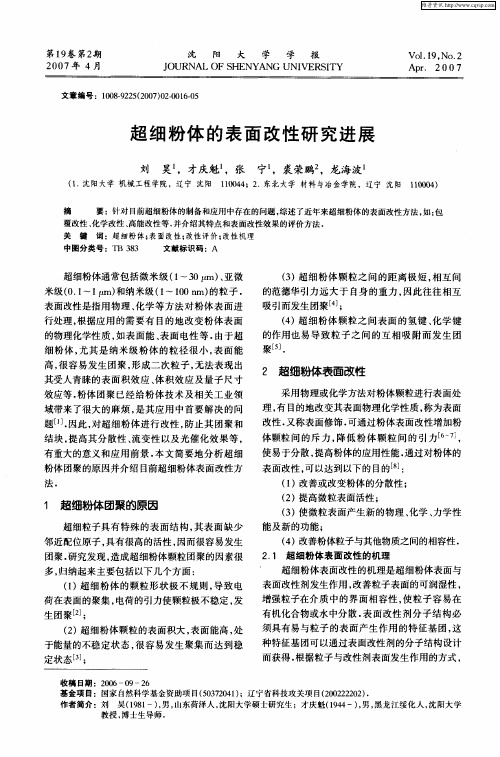
覆改性 、 化学改性 、 高能改性等 . 并介绍其特点和表 面改性效果 的评价方法 .
中图分类号 :T 8 B 33
超 细粉体通 常包括 微 米 级 ( ~3 m)亚微 1 0 、 米 级 ( .~1t 和纳 米级 ( ~10n 的粒 子 . 0 1 m) p 1 0 m) 表 面改性 是指用 物 理 、 化学 等 方 法对 粉 体 表 面进 行 处理 , 据应 用 的需 要有 目的 地改 变 粉 体表 面 根 的物理化 学性 质 , 如表 面 能 、 面 电性 等 . 于超 表 由
域带来了很大的麻烦 , 是其应用 中首要解决的问 题 _. J 因此, J 对超细粉体进行改性 , 防止其团聚和 结块 , 提高其分散性 、 流变性以及光催化效果等 ,
有 重大 的意义和 应 用前 景 . 文 简要 地 分 析超 细 本 粉 体 团聚 的原 因并介绍 目前超 细粉体表 面改性 方
生 团聚【 ; 2 ቤተ መጻሕፍቲ ባይዱ
() 2 超细粉体颗粒的表面积大 , 表面能高, 处
于能量的不稳 定 状 态 , 很容 易 发 生 聚集 而 达到 稳
定状 态 ;
有机化合物或水中分散 . 表面改性剂分子结构必 须具 有易 与粒 子 的表 面 产生 作 用 的特 征 基 团 , 这
种特 征基 团可 以通过表 面改性 剂 的分子结 构设计 而获得 . 据粒 子与改性 剂表 面发 生作用 的方式 , 根
1 超细粉体团聚的原因
超细粒子具有特殊的表面结构, 其表 面缺少
邻 近配位 原子 。 有很 高的活性 , 而很 容易 发生 具 因
团聚. 研究发现 , 造成超细粉体颗粒团聚的因素很
粉体表面改性处理介绍

2)有机酸及其盐类改性剂
❖高级脂肪酸及其盐 结构通式:RCOOH 为阴离子表面活性剂,其结构和聚合物分子结
构相似,与聚合物基料有一定的相容性。分子一 端为羧基,可与无机填料或颜料表面发生物理、 化学吸附作用,另一端为长链烷基(C16-C18)
作用: 用高级脂肪酸及其盐(如硬脂酸)处理无机填料
或颜料,有一定的表面处理效果 可改善无机填料或颜料与高聚物基料的亲和性, 提高其在高聚物基料中的分散度。 本身具有润滑作用,可使复合体系内摩擦力减
(1)干法改性 干法改性是指颗粒在干态下在表面改性设备中首先进
行分散,然后通过喷洒合适的改性剂或改性剂溶液,在一 定温度下使改性剂作用于颗粒材料表面,形成一层改性剂 包覆层,达到对颗粒进行表面改性处理的方法。这种改性 方法具有简便灵活,适应面广,工艺简单,成本低,改性 后可直接得到产品,易于连续化、自动化等优点,但是在 改性过程中对颗粒难以做到处理均一、颗粒表面改性层可 控等目的。
2023最新整理收集 do something
概述
1)定义
粉体表面改性
表面改性是指利用各类材料或助剂,采用物理、 化学 等方法对粉体表面进行处理,根据应用的需要有目的地改 善粉体表面的物理化学性质或物理技术性能,如表面晶体 结构和官能团、表面能、表面润湿性、电性、表面吸附和 反应特性等等,以满足现代新材料、新工艺和新技术发展 的需要。
亲水基的性质
硅烷偶联剂亲水基也称水解性基团,遇水可分解成 活性硅醇(≡Si-OH),通过硅醇和无机矿物表面反应, 形成化学结合或吸附于矿物表面 X为—OCH3和—OC2H5,水解速度缓慢,产物
醇为中性物质,用水介质进行表面改性。 X为—OC2H4OCH3基团,不仅保留水解性,还
能提高水溶性、亲水性,应用更为方便
粉体表面改性及分散技术

1、纳米粉体的分散重要性
纳米粉体稳定分散在各种液相介质形成的分散体本身往往 就是十分重要的产品。如将某些具有特殊电磁性的纳米粉 体分散在液相介质中可制成导电料浆或磁性浆料;将纳米 TiO2粉体分散在水中或有机溶剂中可以制成具有抗紫外、 自清洁或光催化等特殊功能的涂料;这些产品的性能与纳 米粉体的分散状况密切相关。
3、粉体表面改性的目的
4、环境保护
某些公认的对健康有害的原料,如石棉,对人体健康有害主要 在于其生理活性;一是细而长的纤维形状(长度为5-100微米, 直径3微米以下的纤维)在细胞中特别具有活性;二是石棉表面 的极性点(这些极性点主要是OH-官能团)容易与构成生物要素 的氨基酸蛋白酶的极性基键合。如果这两个因素在细胞中起主导 作用的话,那么就可以认为表面改性有可能改变石棉的生理活性。 可用对人体无害和对环境不构成污染,又不影响其使用性能的其 他化学物质覆盖、封闭其表面的活性点OH-。
1、粉体的用途
在橡胶、塑料、涂料、胶粘剂等高分子材料工业及高 聚物基复合材料领域中,无机粉体填料占有很重要的 地位。如碳酸钙、高岭土、氢氧化铝、云母、石棉、 石英、硅藻土、白碳黑等等,不仅可以降低材料成本, 还能提高材料的硬度、刚性和尺寸稳定性,改善材料 的力学性能并赋予材料某些特殊的物理化学性能,如 耐腐蚀性、耐侯性、阻燃性和绝缘性等。
2、纳米粉体分散改性的目的
粉体表面改性及分散技术
主要内容
一.粉体表面改性 二.纳米粉体表面改性 三.超分散剂
超细粉体分类
分类
直径
原子数目
微米粉体
>1m
>1011
亚微米粉体 100nm~1 m 108
特征 体效应 体效应
纳米粉体 100nm~10nm 105 尺寸与表 1nm
超细粉体表面改性研究进展
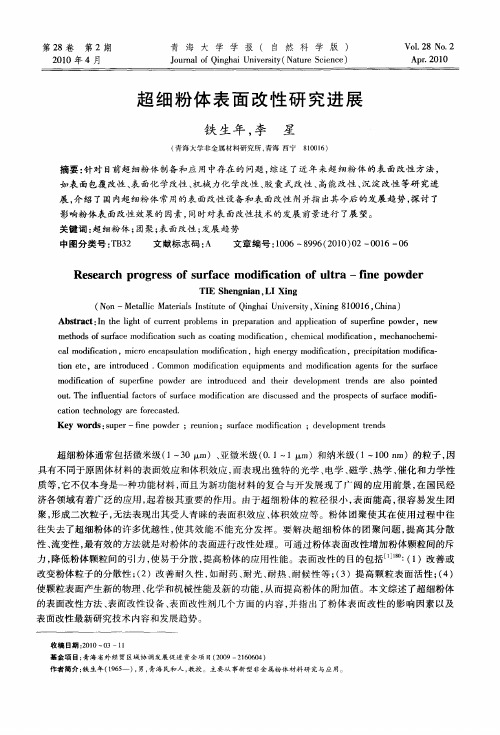
c lmo fc t n,mir n a u ai n mo i c to a di a i i o c o e c ps l t d f ain,h g n r y mo i c to o i ih e e g d f ain,p e iiai n mo fc - i r cp tto di a i
超 细 粉 体 表 面 改 性 研 究 进 展
铁 生年 , 李 星
( 青海大学非金属材料研究所 , 青海 西宁 80 1 ) 10 6
摘要 : 对 目前超 细粉体制 备和应 用 中存在 的 问题 , 述 了近 年 来超 细粉 体 的表 面改性 方 法 , 针 综 如表 面 包覆 改性 、 面化 学改性 、 械 力化 学 改性 、 囊式 改性 、 表 机 胶 高能 改性 、 淀 改性 等研 究进 沉 展, 介绍 了国 内超 细粉体 常 用的表 面改性设 备和表 面 改性剂 并指 出其 今后 的发展 趋势 , 讨 了 探 影 响粉体表 面改性效 果的 因素 , 同时对表 面改性技 术 的发展 前景进行 了展 望。
第2 8卷 第 2期 21 0 0年 4月
Hale Waihona Puke 青 海 大 学 学 报 (自 然 科 学 版 ) Jun l f iga U iesy N tr Si c ) o ra o nh i nvr t( a e c n e Q i u e
Vo I 8 No 2 l2 . Ap . 01 r2 0
关键 词 : 细粉体 ; 超 团聚 ; 面改性 ; 表 发展 趋 势 中图分 类号 :B 2 T 3 文献 标志 码 : A 文章编 号 :0 6— 9 6 2 1 ) 2— 0 6— 6 10 8 9 (0 0 0 0 1 0
Re e r h pr g e s o ur a e m o i c to fulr — fne p wd r s a c o r s fs f c d f a i n o t a — i i o e
超细铜粉表面改性研究现状及展望
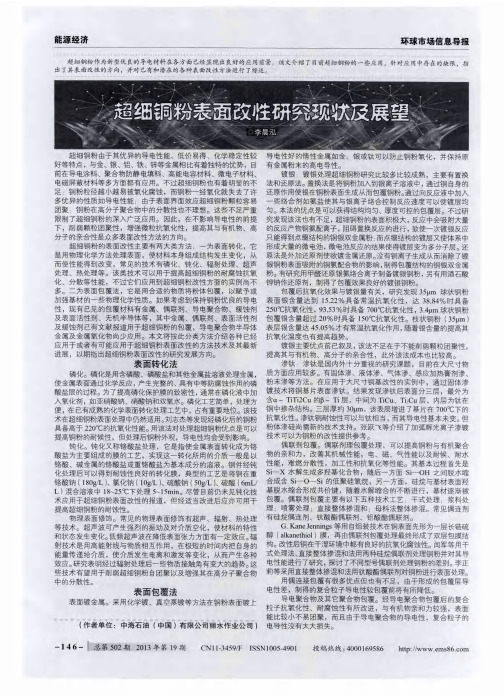
常见 的导 电聚合 物 有 聚 苯胺 ( P An) 、聚吡 咯 ( P P y) 、聚噻 吩 ( P T h)等。常用 的技术有溶解涂覆、化学沉淀、原位聚合等。溶 解 涂 覆 是 将 聚 合 物 或掺 杂后 的聚 合 物溶 于 某 种 溶 液 ,将预 处理 物 质 在 该 溶 液 中 浸 泡 一段 时间 后 取 出烘 干 ,使 溶 质 析 出 涂覆 于 基 材 表 面 的技 术 。 包 覆厚 度 可 以通 过 浸 泡 条件 及 浸 泡 次 数控 制 。该 技 术 的主 要 缺 点 是 能 溶解 导 电聚 合 物 的溶 剂 不 多 。 有 实验 旨在 合 成 水溶性 P An和 P P y ,将 进一 步 扩 展该 法 的应 用 。化 学 沉 淀是 将 基 材放入聚合物单体 的溶液 中,然后 ̄ J D A, g l 发剂使单体 聚合 ,生成 的聚合物沉积在金属颗粒表面将其包覆 ,最后再对聚合物掺杂 以 提 高 其 导 电性 。原 位 聚 合 是 将 聚 合 物单 体 分散 于 颗 粒表 面 然 后 再 使表面单体聚合 ,或者 先用引发剂包覆基材 ,然后在单体溶液 中 使 单 体 在 基 材 表面 聚合 。 另 外 为 使聚 合 物 更 好 地 包 覆金 属 粒 子 有 实验 先 用 偶 连 剂对 金 属 粒 子 进 行 处理 然 后 再 包 覆 导 电 聚合 物 。 目 前该方面的研究尚不多 , w.P r i s s a n a r o o n等用电化学沉淀 法制备 了聚Ⅱ 比 咯包覆 的铜 电极 ,V a n d a n a S h i n d e等用循环伏安法制备 了 聚茴香胺包覆表面 的铜基 ,可以为进一步用聚合物包覆铜粉提供 参考。V a n d a n a S h i n d e等制备 了聚邻 甲基苯胺包覆的铜粉 。研究 结果显示聚 甲基苯胺 与铜粉结合牢固。复合物在抗氧 化耐腐蚀 方 面均强于未处理铜粉 ,其在氯化物环境 中更有显著的抗腐蚀性。 导电聚合物包覆有许 多预计 的优 点。但 目前这方面的理论 尚 不成熟 ,没有明确 的理论指导 ,同时包覆后的粒子最 高使用温度 在2 0 0 ℃ 左 右 ,满足 不 了高 温抗 氧 化 要 求。 其 它聚合物 包覆主要作 用是改 善铜 粉抗氧 化、耐腐蚀 性。 J e o n g h w a n Ki m 等 用 机械 球 磨 技 术 ,先后 加入 聚 酰 胺 、 蓖麻 油 脂 与铜 粉 一 起研 磨 ,最 终 形 成 两 种 物质 共 包 覆 的 复 合 物 。改 性 后 铜 粉 抗 氧 化 性得 到 了提 高 。 缓蚀剂处理。在腐蚀介质中添加 少量 ( 1 %左右)阻止基体腐 蚀 继 续 进 行 的 介质 称 为缓 蚀 剂 。缓 蚀 剂 种 类 很 多 , 已用 于 铜 粉 改 性 的有咪唑化合物和有机酸。咪唑化合物与金属铜 有很好 的配位 反 应 活 性 ,能 瞬 间 吸 附在 铜 表面 ,生 成 致 密 的 防氧 化 、抗 腐 蚀 薄 膜。该法的优 点是 处理过后铜在 空气 、水或弱酸 、稀碱 中具有耐 腐蚀性。水中存储 1 0 0天不被氧化 ,强酸 强碱中完全不腐蚀时间 最长可达数十小时。其与铜 粉表面作用是复杂的化学反应 ,主要 经历 了三个阶段 , 另外咪唑化合 物种类很多 ,对含烷基支链苯骈三氨唑 ( B T A)进 行研 究发现 , 烷 基支链长短对铜 的在 Na C1 溶液和 Na C 1 0, 溶液中 的抗蚀效果有一定影响。有机酸是另一种常用缓蚀剂 ,具体用油 酸 钝 化铜 粉 可 以使 铜 粉 具 备 较好 的抗 氧 化 性 和 分散 性 。 用 该 法 处 理的超细铜粉 有良好的分散 性和抗氧化性 ,但处理后铜粉导 电性 下降 ,同时将 处理后铜粉用于环氧 一聚酰胺树脂 中抗氧化能力也 比较差。因此用油酸处理比较适合于铜粉 的存储。 表面活性 剂处理 。经表 面活性剂处理 后的铜粉表面能减小 , 表面由亲水性变为亲油性的 , 从而可以改善其与有机物的亲和性 , 提高它在 塑料 、橡胶、胶粘 剂等高聚物基复合材料填充时的相容 性 和 分散 性 ;另 外 ,表 面 活性 剂 包 覆 可 以 使铜 粉 与空 气 隔 绝 ,也 能起到一定 的抗氧化作用。金寿 日等用油酸 醇蒸汽对超细铜粉进 行表面处理 ,使其表面包覆一层致密的膜 ,样 品再经真空烧制最 终得 到导 电性膜 ,改善 了铜粉 的抗氧化和分散性能。 无机半导体包覆。渗硅 渗硅 目前用于超细铜粉改性的报道 尚不多 ,但 已有文章在 4 0 0 ~ 5 0 0 。 C 下使硅烷气体分解制备 了包覆 结构的大尺寸铜件。渗硅 处理能增加铜件的耐磨性 ,同时使其具 备常温及 高温抗氧化性。该 法经改进后有望实现对超细钢 粉的改 性 ,形成耐磨 ,耐腐蚀 ,具 有高温抗氧化性而且导 电性 良好的复 合超 细粉 末 。 半 导体 化合 物 包 覆 :可 用于 包 覆 的半 导体 氧 化 物 很 多 ,比如 炭 化硅 、 二氧 化 钛 、 三氧 化 铬 、三 氧 化 铁 、氧 化 锌 等 。 用 这 些物 质 包 覆 的铜 粉 在 保 持较 高导 电性 前 提 下 可 以使 铜 粉 具 备 高 温抗 氧 化性 ,同时也能改变金属表面活性 ,方便进 一步 处理。可以实现 这 方面 包 覆 的技 术 也 很 多 ,如 溶 胶 一凝胶 法 、沉 淀 法 、 非均 相 成 核 法 、乳 液 法等 。但 具 体 实 现对 铜 粉 的 实例 不 多 。V D. S t a n k o v i c 等将半导体 Mo S 、C、S i C、Ah O 包覆于铜基 片表面 ,并对包覆 后表面结构形貌 ,表面硬度 ,及包覆后伸展性进 行了研究 ,可以 为铜 粉处理提供参考。 针对 同样的 目的 ,用于实现的方法、技术很多 ,超细粒子的
超细粉体分级技术

分级技术的绿色化
环保材料
选用低污染、可降解的环 保材料,降低对环境的影 响。
能耗降低
采用高效节能技术和设备, 降低分级过程中的能源消 耗。
废弃物资源化
对分级过程中产生的废弃 物进行资源化利用,减少 对环境的负担。
分级技术的精细化
高精度分级
提高分级设备的精度和稳定性,实现超细粉体的精细 分级。
粒度分布控制
分级技术的意义
01
02
03
提高产品质量
通过精确的分级技术,可 以去除不合格的粉体颗粒, 提高产品的纯度和均匀性。
优化生产工艺
合理的分级技术能够实现 连续、高效的粉体生产, 降低能耗和生产成本。
拓展应用领域
随着分级技术的不断改进, 超细粉体的应用领域将进 一步拓展,为各行业带来 更多的发展机遇。
02
超细粉体的颗粒形态多样,可以是球形、立方体、片状等。颗粒形态对粉体的 物理和化学性质有重要影响,如比表面积、孔隙率、吸附性能等。
颗粒形态控制
可以通过物理或化学方法对超细粉体的颗粒形态进行控制,以提高其应用性能。 例如,采用球磨、化学气相沉积等方法可以制备出具有特定形态的超细粉体。
表面性质
表面性质
超细粉体的表面性质对其应用性能具有重要影响。由于粒径小,超细粉体的比表面积大,表面能高, 容易发生团聚现象。因此,需要对超细粉体的表面进行改性处理,以提高其分散性和稳定性。
应用
气流分级广泛应用于超细粉体的制备和分级,如硅微粉、碳化硅、石墨烯等。通过气流分级技术,可以获得粒度 均匀、纯度高的超细粉体产品。
静电分级
原理
静电分级是利用静电场将不同粒度的粉 体颗粒进行分离。在静电场的作用下, 颗粒受到的电场力与颗粒的电导率和电 荷量成正比。因此,通过控制电场强度 和电场方向,可以将不同粒度的粉体颗 粒进行有效分离。
粉体表面处理技术

粉体表面处理技术
嘿,你问粉体表面处理技术?这事儿还挺有意思呢!咱就来唠唠。
这粉体啊,就像一群小不点儿,到处乱跑。
要是不处理一下它们的表面,那可不行。
为啥呢?因为粉体的表面会影响它们的性能啊。
比如说,有的粉体容易吸水,有的粉体容易结块,有的粉体颜色不好看。
这些问题都可以通过表面处理技术来解决。
那粉体表面处理技术都有啥呢?首先呢,有一种叫包覆的方法。
就像给粉体穿上一件衣服一样,把一种材料裹在粉体的表面。
这样可以改变粉体的性能,比如说让它更防水、更耐磨、更漂亮。
可以用各种材料来包覆粉体,像有机物啊、无机物啊啥的。
然后呢,还有一种叫改性的方法。
就是把粉体的表面改一改,让它变得更适合某种用途。
比如说,把粉体的表面变得更亲水,这样它就能在水里更好地分散;或者把粉体的表面变得更亲油,这样它就能在油里更好地溶解。
改性的方法有很多种,可以用化学方法啊、物理方法啊啥的。
还有啊,有一种叫表面活化的方法。
就是让粉体的表面变得更活泼,更容易和其他材料结合。
比如说,用一些特殊的试剂来处理粉体的表面,让它带上一些活性基团。
这样粉体就能和其他材料更好地反应,形成更强的结合力。
哎呀,粉体表面处理技术可真是五花八门啊!不同的方法适用于不同的粉体和不同的用途。
要想用好这些技术,就得了解粉体的性质和需求,然后选择合适的方法。
下次你要是看到粉体,就会知道它们的表面可能经过了什么样的处理啦。
加油吧!。
粉体表面改性方法原理、工艺技术及使用的粉体改性剂
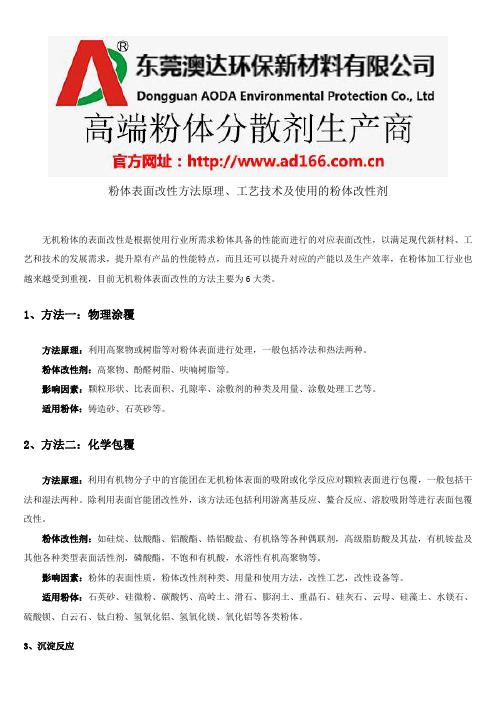
粉体表面改性方法原理、工艺技术及使用的粉体改性剂无机粉体的表面改性是根据使用行业所需求粉体具备的性能而进行的对应表面改性,以满足现代新材料、工艺和技术的发展需求,提升原有产品的性能特点,而且还可以提升对应的产能以及生产效率,在粉体加工行业也越来越受到重视,目前无机粉体表面改性的方法主要为6大类。
1、方法一:物理涂覆方法原理:利用高聚物或树脂等对粉体表面进行处理,一般包括冷法和热法两种。
粉体改性剂:高聚物、酚醛树脂、呋喃树脂等。
影响因素:颗粒形状、比表面积、孔隙率、涂敷剂的种类及用量、涂敷处理工艺等。
适用粉体:铸造砂、石英砂等。
2、方法二:化学包覆方法原理:利用有机物分子中的官能团在无机粉体表面的吸附或化学反应对颗粒表面进行包覆,一般包括干法和湿法两种。
除利用表面官能团改性外,该方法还包括利用游离基反应、鳌合反应、溶胶吸附等进行表面包覆改性。
粉体改性剂:如硅烷、钛酸酯、铝酸酯、锆铝酸盐、有机铬等各种偶联剂,高级脂肪酸及其盐,有机铵盐及其他各种类型表面活性剂,磷酸酯,不饱和有机酸,水溶性有机高聚物等。
影响因素:粉体的表面性质,粉体改性剂种类、用量和使用方法,改性工艺,改性设备等。
适用粉体:石英砂、硅微粉、碳酸钙、高岭土、滑石、膨润土、重晶石、硅灰石、云母、硅藻土、水镁石、硫酸钡、白云石、钛白粉、氢氧化铝、氢氧化镁、氧化铝等各类粉体。
3、沉淀反应方法原理:通过无机化合物在颗粒表面的沉淀反应,在颗粒表面形成一层或多层“包膜”,以达到改善粉体表面性质,如光泽、着色力、遮盖力、保色性、耐候性、电、磁、热性和体相性质等。
粉体改性剂:金属氧化物、氢氧化物及其盐类等各类无机化合物。
影响因素:原料的性质(粒度大小和形状、表面官能团),无机表面改性剂的品种,浆液的pH值、浓度,反应温度和反应时间,洗涤、脱水、干燥或焙烧等后续处理工序。
适用粉体:钛白粉、珠光云母、氧化铝等无机颜料。
4、机械力化学方法原理:利用超细粉碎及其他强烈机械作用,有目的的对粉体表面进行激活,在一定程度上改变颗粒表面的晶体结构、溶解性能(表面无定形化)、化学吸附和反应活性(增加表面活性点或活性基团)等。
水镁石粉湿法超细制备和表面改性一体化研究

多得的绿色环 保 阻燃 剂 , 近年 来 已经成为 阻燃剂 产业 中 发展较 快 的品种[3 21 ,。但 水镁 石用做 阻燃剂 又存 在 以下
缺点:一是 阻燃效 率较低 ,要达 到较好 的阻燃效 果就必
01 3 ;7 0 .3 5 0 ℃烧 失量 :2 . 。D 0 .4t 82 7 5 为09 1 . m,D9 为 0
生成的氧化镁 化学 性质稳 定的优点 , 因此 它是一 种不可
2 实
ห้องสมุดไป่ตู้验
21 实验 原料、试剂 、设备 . 辽 宁丹东某矿 业公 司提 供 的水镁 石粉 , 化学 组成如
下 ( ) % :Mg O-6 .4;Ca 40 O:10 ;S O2 .5 ;F 2 : .2 i -56 6 e03
关键词 : 水镁石 ;超 细 ;表 面改性 ;一体 化
中图分 类号 : T 3 B2
文献标 识码 :A
文章编号 : 1 0 .7 12 0 ) 0 19 3 (0 7增刊.890 2 1 .3
1 引 言
水镁 石的主要 成份为氢氧 化镁 , 是 自然界 中产 出 它 的一种含镁 量较 高的矿物 【。它可 以用 作聚合物 材料 的 】 】 阻燃剂 , 在应 用时依靠 化学 分解 吸热 以及 释放 出的水 而 起到阻燃作 用 ,具有 无毒性 、不腐蚀加工 机械 、分解后
维普资讯
丰世 凤 等 : 水镁 石粉 湿 法 超 细制 备 和表 面 改 性一 体化 研 究
水镁 石粉 湿法 超细制 备和表 面改性 一体 化研 究木
丰世 凤 , 宁桂玲 ,李 鑫 ,林 源
( 大连理 工大学 化 工学 院,精细化 工 国家 重点实验 室,辽 宁 大连 16 1 ) 10 2
- 1、下载文档前请自行甄别文档内容的完整性,平台不提供额外的编辑、内容补充、找答案等附加服务。
- 2、"仅部分预览"的文档,不可在线预览部分如存在完整性等问题,可反馈申请退款(可完整预览的文档不适用该条件!)。
- 3、如文档侵犯您的权益,请联系客服反馈,我们会尽快为您处理(人工客服工作时间:9:00-18:30)。
• 第一,有机改性剂在颗粒表面的覆盖,以 提高无机粉体在有机基体中的分散性和界 面结合强度;
• 第二,通过化学沉积或机械力化学作用将 固体小颗粒(子颗粒)或均一物质膜在较 大颗粒表面(母颗粒)均匀包覆形成复合 颗粒,从而赋予复合颗粒新的功能;
• The structure of the nickel rich surface differed with the treatment conditions. For acetic acid treated powder prepared in heated solution, a nanocrystalline nickel layer was formed at the surface. In the absence of any auxiliary conductivity additives, discharge capacity of this powder was improved to 254 mAh/g versus 52 mAh/g for non-treated powder and 62 mAh/g for hydrochloric acid treated powder.
• 静电分散作用:通过表面改性使颗粒的荷 电量增大;通过表面改性改变颗粒表面性 质,消除液桥力的影响。
• 降低纳米粉体的团聚度、提高其流动性
合金粉末真空雾化设备
Effects of surface modification on surface structure and electrochemical properties of Mm(Ni,Co,Mn,Al)5.0 alloy
Results
• The pH value varied from 0.8 to 6.5 with incremental changes as a function of time during hydrochloric acid surface modification, and the pH value of acetic acid solution showed an almost linear increase from 2.6 to 3.1 for 0.6 ks at room temperature. After heating to 368 K, the pH rose to 4.2, as shown in Fig. 2.
超细粉体表面特性
• 超细粉体表面的润湿性 • 超细粉体的表面电性 (颗粒与其他介质接触时,表面会有电荷转
移,这种转移往往正负电荷数量不一致, 从而产生电势差。) • 超细粉体的表面能
超细粉体表面改性
• 表面改性是的地改变颗粒表面物理化学性质与表面形 态结构工艺。
• Two acids, hydrochloric (0.27 mol/l) and acetic (3.4 mol/l), were used for surface modification. The weight ratio of powder to solution was held constant at 1:1, and the solution was magnetically stirred. The solution was kept at room temperature for hydrochloric acid treatment, while the acetic acid solution was reacted at room temperature for 0.6 ks and then heated to increase the speed of reaction.
Abstract
• The electrochemical properties of MmNi5type metal hydride powders produced by gas atomization were improved by acid surface modification. FIB specimen preparation followed by FE-TEM observation was used to analyze the surface structure before/after surface modification. The original oxide layer of the surface was removed and a nickel rich layer was formed by acid treatment.
Introduction
• (Mm: La 33%, Ce 48%, Pr 5%, Nd 14%)
• MmNi5-type metal–hydride (MH) alloy powders are widely used for the negative electrodes of nickel/MH batteries. Much effort has been devoted to finding substitutes for Ni to improve basic electrode properties such as discharge capacity and cycle life. Modern alloy systems are primarily of the type Mm–Ni– Co–Mn–Al.
Experimental
• The MH alloy powder whose composition is Mm1.0Ni3.6Co0.6Mn0.6Al0.2 (Mm: La 33%, Ce 48%, Pr 5%, Nd 14%)was produced by Ar gas atomization after being melted in a 2 kg capacity induction furnace under an Ar atmosphere.
超细粉体表面包覆与改性
• 超细粉体表面是指表面的一个或几个原子 层,有时指厚度达几微米的表面层。表面 是体相结构的终止,表面向外的一侧没有 近邻原子,表面原子有一部分化学键形成 悬空键。
• 超微粉体内部的三维周期势场在表面中断 ,表面原子的电子状态也和体内不同,然 而表面不是体相结构的简单终止。由于超 微粉体表面有悬空键,因而有剩余成键能 力。为了使表面能降低,所有超微粉体的 表面原子都会离开它们原来在体相中应占 的位置而进入新的平衡位置,发生弛豫和 重构。因此导致颗粒表面有很高的活性。
• Table 1 shows the discharge capacity before/after hydrochloric acid and acetic acid surface treatment. Without surface treatment, the value of the standard conductivity electrode was 213 mAh/g, which is only 63% of the theoretical capacity (340 mAh/g). After acid treatment, the discharge capacity of the standard electrode increased, nearing the theoretical value for both acids.
• The atomized powder was sieved to less than 180 μm and its average particle diameter was 59 μm.
• The sieved powder was then heat treated at 1073K for 36 ks under an Ar atmosphere. A SEM image of the atomized powder is shown in Fig. 1.
powder
K. Yanagimoto a,∗, K. Majimab, S. Sunada b, T. Sawadaa
a Sanyo Special Steel Co. Ltd., 672-8677 Himeji, Japan b Faculty of Engineering, Toyama University, 930-8555 Toyama, Japan
• Surface modification was terminated when the solution pH reached 6.5 for hydrochloric acid or solution temperature exceeded 368K for acetic acid.
• A TEM specimen was prepared with FIB for thinning the area of interest of the MH powder particle and observed with FETEM. The surface layer of the particle was characterized by EDS analysis and electron diffraction.
• 具体:
• 超声波利用超声空化时产生的局部高温、 高压或强冲击波和微射流等,较大幅度地 弱化超微粒子间的超微作用能,有效地防 止超微粒子团聚而使之充分分散。
• 辐照技术将高能射线与物质相互作用时, 在极短的时间内即把自身的能量传递给介 质,使介质发生电离和激发等变化。
• 采用等离子体方法处理无机粉体,使表面 引入活性基团或使表面包覆聚合物,提高 与聚合物的黏合性、改善聚合物填充体系 的力学性能。
• 偶联剂具有两性结构,其分子中的一部分 基团可与粉体表面的各种化学官能团反应 ,形成强有力的化学键。另一部分基团则 与有机高聚物发生某些反应或物理缠结, 从而将两种性质差异很大的材料牢固地结 合起来,使无机填料和有机高聚物之间产 生具有特殊功能的“分子桥”。
